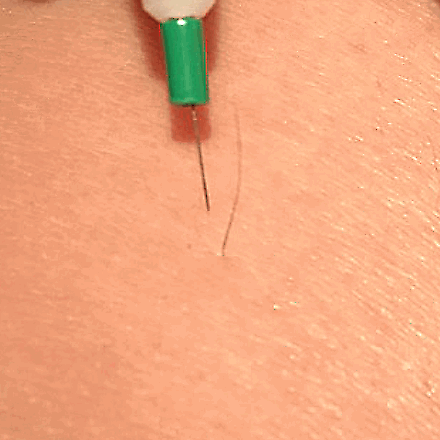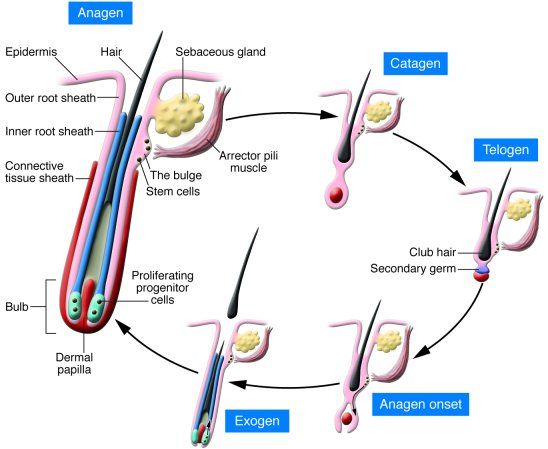What is Electrolysis and how does it permanently remove my hair?
*We start with a tiny sterilized filament and then slide it into a hair follicle that containing a visible hair. This hair can be as short as 1-1.5mm.
*Then the electrical current is turned on. This can take under a second or up to 30 seconds depending on the modality and strength of the hair root. The current cauterizes the hair follicle and loosens the hair.
*Next, the treated hair is removed with sterilized tweezers. With enough current, this hair will either grow back in finer or never to grow again.
*The process is continued onto the next unwanted visible hairs until the desired area is cleared OR the time of the appointment is up (full clearance may not be achievable in one session and you most likely will need multiple sessions).
*Then the electrical current is turned on. This can take under a second or up to 30 seconds depending on the modality and strength of the hair root. The current cauterizes the hair follicle and loosens the hair.
*Next, the treated hair is removed with sterilized tweezers. With enough current, this hair will either grow back in finer or never to grow again.
*The process is continued onto the next unwanted visible hairs until the desired area is cleared OR the time of the appointment is up (full clearance may not be achievable in one session and you most likely will need multiple sessions).
So is that it? Will I only need a few sessions?
*The hairs treated in one appointment are only the tip of the iceberg. Many seemingly "empty" hair follicles are either temporarily resting or in the process of regrowing a new hair.
*All hairs are growing in cycles which means: when the next batch of hairs appear, it's time to return for another treatment. This is repeated every 2-6 weeks until permanent results are achieved.
*How long one takes to reach their outcome varies on many factors and is best explained with a consultation.
*All hairs are growing in cycles which means: when the next batch of hairs appear, it's time to return for another treatment. This is repeated every 2-6 weeks until permanent results are achieved.
*How long one takes to reach their outcome varies on many factors and is best explained with a consultation.
J Clin Invest. 2006;116(1):19-22. https://doi.org/10.1172/JCI27490.
Our hair grows in cycles and repeated treatments is a must to reach one's goal of permanent hair removal.
Our hair grows in cycles and repeated treatments is a must to reach one's goal of permanent hair removal.
Why would you choose Electrolysis over L.A.S.E.R.
L.A.S.E.R. is FAST, large areas of the body can be treated in under an hour and small areas can be done in minutes. Electrolysis is done hair by hair and can take an hour or more for smaller areas (depending on how dense the hairs are). So why choose Electrolysis???
- If you were told you were not a candidate for L.A.S.E.R. because you have grey, blonde or red hairs or you have darker skin (or many freckles) and lighter hairs, you can turn to Electrolysis.
- You have completed your series of L.A.S.E.R. treatments and you have unwanted hairs left behind. Electrolysis will be able to remove these hairs.
- If you are looking for permanent hair removal vs long term reduction.
- If you want permanent hair removal near or on tattoos.
ELECTROLYSIS IS CONSIDERED BY THE FDA TO GIVE PERMANENT REMOVAL, BUT WHY?
For a hair to never grow again, the stem cells within the hair follicle needs to be fully destroyed, If there are remaining stem cells, it is theorized that the damaged follicle can eventually regenerate itself and form a hair.
A damaged follicle from L.A.S.E.R. or Electrolysis can regrow a hair, but it will be thinner. More treatments is needed by L.A.S.E.R. or Electrolysis to fully destroy the follicle. After enough treatments, L.A.S.E.R can max out it's settings depending on skin color or not be able to be effective on certain hair colors. Then the series of L.A.S.E.R. ends. If there are remaining hairs, Electrolysis will be a viable option to continue on the permanent removal treatments. Why?
Electrolysis has the flexibility to fully destroy the follicle stem cells since the energy settings are not based on the melanin within a hair or skin and the energy is placed directly inside the hairs follicle. The result can be full clearance of unwanted hairs in an area.
A damaged follicle from L.A.S.E.R. or Electrolysis can regrow a hair, but it will be thinner. More treatments is needed by L.A.S.E.R. or Electrolysis to fully destroy the follicle. After enough treatments, L.A.S.E.R can max out it's settings depending on skin color or not be able to be effective on certain hair colors. Then the series of L.A.S.E.R. ends. If there are remaining hairs, Electrolysis will be a viable option to continue on the permanent removal treatments. Why?
Electrolysis has the flexibility to fully destroy the follicle stem cells since the energy settings are not based on the melanin within a hair or skin and the energy is placed directly inside the hairs follicle. The result can be full clearance of unwanted hairs in an area.
DOES IT HURT?
Most forms of hair removal causes discomfort, Electrolysis is no different. Some hairs you will feel almost nothing and some hairs have an "overactive" nerve nearby. If you have had laser hair removal you may have noticed certain pulses felt fine and others hurt really bad. Same with tweezing, some random eyebrow hairs are more painful than others.
If pain is a concern, you can buy an over the counter Lidocaine numbing cream such as Emla or Maxeline (look for 5% strength) at any pharmacy. Ask the Pharmacist since its kept behind the counter and no prescription should be needed. Apply 45 minutes before appointment and make sure to cover the cream on your skin with saran wrap (to avoid it drying out and losing potency).
I can apply a small amount of a milder numbing cream at the start of your appointment, but the effect won't be as potent as Emla or Maxeline since there will not be enough time for the numbing to set in.
If pain is a concern, you can buy an over the counter Lidocaine numbing cream such as Emla or Maxeline (look for 5% strength) at any pharmacy. Ask the Pharmacist since its kept behind the counter and no prescription should be needed. Apply 45 minutes before appointment and make sure to cover the cream on your skin with saran wrap (to avoid it drying out and losing potency).
I can apply a small amount of a milder numbing cream at the start of your appointment, but the effect won't be as potent as Emla or Maxeline since there will not be enough time for the numbing to set in.
ELECTROLYSIS IS BASED ON TIMED APPOINTMENTS SO, HOW MUCH TIME DO I NEED?
Answer to question 3
A consultation is recommended because timing is dependant on the size of the area, the density of hair, type of electrolysis used and pain tolerance. If one cannot treat all the unwanted hairs in the area, then book back in within a week to clear the rest up.
15 or 30 minutes is a good place to start for your first treatment, but please don't expect all the unwanted hairs to be treated in the one session. This first session is to give you an idea of how the treatments feel and how much coverage you can get in a specific timed appointment.
15 or 30 minutes is a good place to start for your first treatment, but please don't expect all the unwanted hairs to be treated in the one session. This first session is to give you an idea of how the treatments feel and how much coverage you can get in a specific timed appointment.
Answer to question 4
I HAD A SESSION LESS THAN A WEEK AGO AND THERE ARE HAIRS GROWING BACK IN. DOES THIS MEAN THE LAST TREATMENT DIDN'T WORK?
There is the possibility of missed hairs from the treatment, but most likely a new cycle of hairs have started. The hairs that were treated in the last session was only a small percentage of the actual amount of hair follicles in that area. We are covered in millions of hair follicles and the hairs come and go in cycles. If they all arrived at once we would have periods throughout the year where we would be bald or have dense "fur" like an animal. We could have no hair on our head once every seven years and a crazy thick mustache for a couple of weeks once every 2-3 months. Our head, body parts and facial areas all have hair cycles with their own lengths of time.
To give our skin constant protection from the elements, the hair follicles are regulated to always have some hair present. Some are falling out while others are growing beneath the skin and getting ready to emerge. Other hair follicles may be temporarily resting and others are inactive until hormones "wake" them up and they grow their first hair.
It may seem we are always chasing the hair cycles, and we are! Eventually with enough sessions, we catch up and beat the hair cycles. The area is then free from growing hairs unless a change in hormones occur or one has been tweezing/waxing in between Electrolysis treatments.
For example: menopause starts and the once fine light hairs start growing in darker and coarser and/or inactive hair follicles are stimulated by hormones and they start growing hairs for the first time ever. Once an inactive follicle awakens, very rarely do they become inactive again.
To give our skin constant protection from the elements, the hair follicles are regulated to always have some hair present. Some are falling out while others are growing beneath the skin and getting ready to emerge. Other hair follicles may be temporarily resting and others are inactive until hormones "wake" them up and they grow their first hair.
It may seem we are always chasing the hair cycles, and we are! Eventually with enough sessions, we catch up and beat the hair cycles. The area is then free from growing hairs unless a change in hormones occur or one has been tweezing/waxing in between Electrolysis treatments.
For example: menopause starts and the once fine light hairs start growing in darker and coarser and/or inactive hair follicles are stimulated by hormones and they start growing hairs for the first time ever. Once an inactive follicle awakens, very rarely do they become inactive again.
I have a rash or red dots now. Will it go away
Yes, it is normal to leave the appointment with red and sometimes puffy skin. This should go away with the day, but sometimes with intensive treatments sometimes it could last a couple days.
Sometimes bacteria can get into the treated follicles and this can cause tiny pimples. Do not pick at them. Keep them clean with daily washing with a gentle soap and protect them with aloe gel or polysporin.
On the body or on the face (with very coarse hairs), it is more common that red dots may last a couple of days up to a week. This is a part of the healing process and nothing to worry about. As long as one does not rub, shave over or pick at them, it should disappear without any complications.
Picking, scratching or applying harsh creams on pimples and red dots that are healing can cause scarring....same goes for ingrown hairs!
Sometimes bacteria can get into the treated follicles and this can cause tiny pimples. Do not pick at them. Keep them clean with daily washing with a gentle soap and protect them with aloe gel or polysporin.
On the body or on the face (with very coarse hairs), it is more common that red dots may last a couple of days up to a week. This is a part of the healing process and nothing to worry about. As long as one does not rub, shave over or pick at them, it should disappear without any complications.
Picking, scratching or applying harsh creams on pimples and red dots that are healing can cause scarring....same goes for ingrown hairs!
What is the aftercare?
*Please try not to touch the treated area with unwashed hands for several hours. Children or pets should not touch the treated area either, for bacteria can get into the treated follicle and cause pimples.
*If the area feels warm, you can use an ice pack wrapped in a clean tea towel.
*Keep the area clean with a gentle soap and apply aloe. Do not apply any peeling/exfoliating lotions within 24 hours of your treatment.
*Apply a sunblock for several days afterwards. Tiny freckles can appear in a newly treated area if one uses a tanning bed or spends several hours in the sun.
*No picking, exfoliating or waxing in the treated area while the skin is healing. This could cause prolonged healing or scarring. Once the skin has returned to normal, so can your skin routine.
*If the area feels warm, you can use an ice pack wrapped in a clean tea towel.
*Keep the area clean with a gentle soap and apply aloe. Do not apply any peeling/exfoliating lotions within 24 hours of your treatment.
*Apply a sunblock for several days afterwards. Tiny freckles can appear in a newly treated area if one uses a tanning bed or spends several hours in the sun.
*No picking, exfoliating or waxing in the treated area while the skin is healing. This could cause prolonged healing or scarring. Once the skin has returned to normal, so can your skin routine.
Can I also get waxing or LASER services in the same area?
NO, electrolysis is dependant on treating visible hairs. Waxing, Tweezing and LASER will remove the immediate hairs AND interrupt the upcoming hair cycles. This will prolong your Electrolysis permanent hair removal results. It's best to trim the unwanted hairs in between Electrolysis appointments.
If you are taking a long break from Electrolysis, then by all means go for the other hair removal techniques. If your wanting to do Laser & Electrolysis, start with Laser first and when your done your sessions, you can finish up with Electrolysis.
If you are taking a long break from Electrolysis, then by all means go for the other hair removal techniques. If your wanting to do Laser & Electrolysis, start with Laser first and when your done your sessions, you can finish up with Electrolysis.
I have done Electrolysis for years on my face. Will it end
Electrolysis should be having an effect on your hairs. Think back to a time when you saw/felt a coarse hair slowly change to a softer and finer hair and eventually disappear. Unfortunately, as we age our hormones change and this means our hair changes too.
Typically for women, we get more darker, thicker and longer hairs on our face. Men will find back, shoulder and upper arm hair become more prominent. These hairs were once fine vellus hair that one could only see in the sun OR a follicle in your skin never produced a hair until... our hormones started to change.
Typically a woman may expect a "new" coarse, long hair to pop up a couple times a year after menopause. This will require a maintenance treatment here and there throughout the year.
If a woman has PCOS or an adrenal disorder, she may require lifelong maintenance treatments every month or so until her condition is under control through medication.
Take hope in that once a hair follicle has been successfully treated (meaning no stem cells remain), that follicle has been permanently destroyed and will never regrow a hair.
Typically for women, we get more darker, thicker and longer hairs on our face. Men will find back, shoulder and upper arm hair become more prominent. These hairs were once fine vellus hair that one could only see in the sun OR a follicle in your skin never produced a hair until... our hormones started to change.
Typically a woman may expect a "new" coarse, long hair to pop up a couple times a year after menopause. This will require a maintenance treatment here and there throughout the year.
If a woman has PCOS or an adrenal disorder, she may require lifelong maintenance treatments every month or so until her condition is under control through medication.
Take hope in that once a hair follicle has been successfully treated (meaning no stem cells remain), that follicle has been permanently destroyed and will never regrow a hair.


